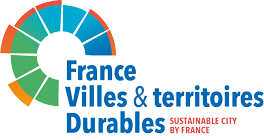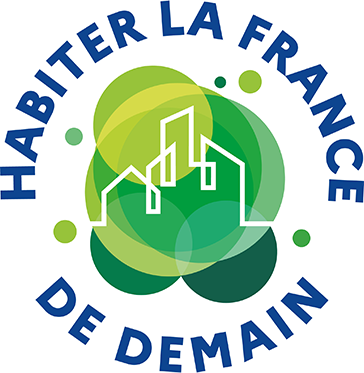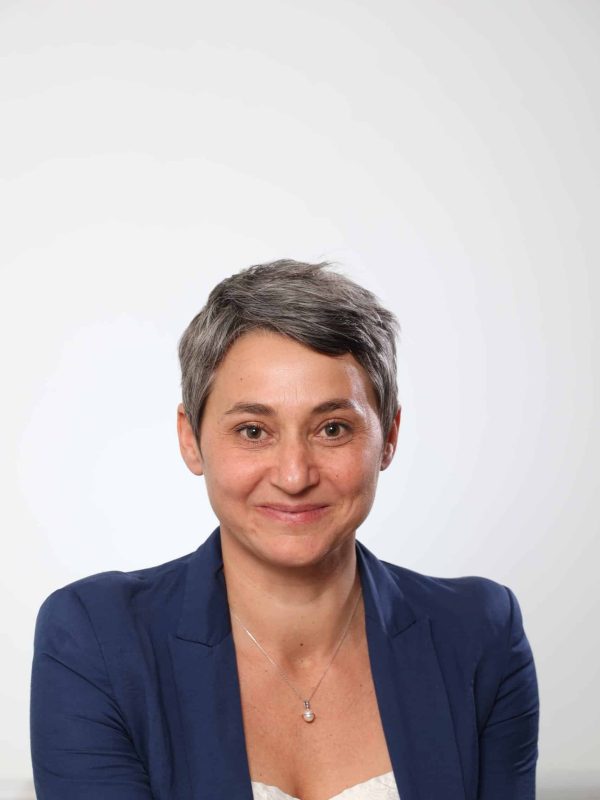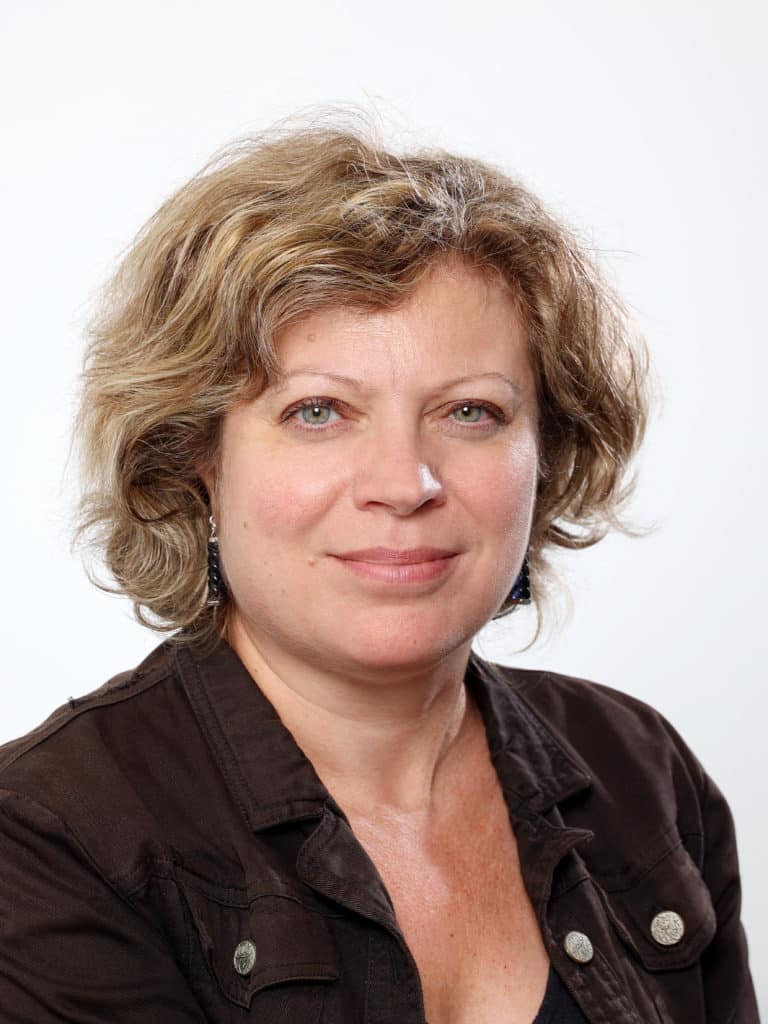Hibiscus EcoNeighborhood
A project proposed by Construction 21
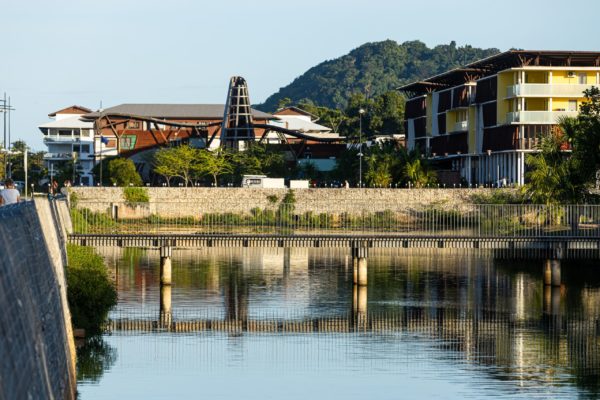
Contributor
urbain@epfag.fr
Description
The project is part of the process of creating the new "Hibiscus University district" in Cayenne. This new district is strategic for the city and for all French Guyana, since it must allow for the development of the sector and the integration of the University of Guyana into the city, as well as the creation of housing, activities and facilities essential to the functioning of the territory.
The ambition of the project is to create a piece of the city that is not an enclave. In other words, a district fully integrated into the city of Cayenne that takes into account the strong characteristics of the Guianese territory: its road system, its social, demographic, economic and land situation, its unequalled biodiversity, and finally a hot and humid climate and high natural risks.
To achieve this, several principles have dictated its design:
- INSERT THE NEIGHBORHOOD INTO THE CITY AND THE AREA by means of a road network that is consistent with the existing network and regular public transport services,
- CREATE A NEW "PIECE OF CITY" offering a social and functional mix, meshed on the scale of the pedestrian route, as an urban centre should be,
- PROPOSE A MIXED PROGRAM RESPONDING TO THE NEEDS OF THE AREA AND PROMOTING SOCIAL DIVERSITY, a broad mix of housing, a range of facilities, places for social exchange and a large commercial area,
- PROMOTING THE LIVING ENVIRONMENT by developing quality public spaces that take into account the characteristics of the Guyanese climate: the central square, the urban boulevard, the landscaped streets, the large retention basin and its health trail are the unifying elements of the new district,
- ENHANCE THE NATURAL AND LANDSCAPE HERITAGE by maintaining a strong presence of water and green spaces in order to link the district to its natural environment,
- TO APPLY A BIOCLIMATIC APPROACH IN THE URBAN AND ARCHITECTURAL DESIGN TO ENSURE THE DISTRICT'S ENERGY SOBRIETY,
- AND FINALLY, TO PROPOSE AN INNOVATIVE RESPONSE TO THE RISK OF FLOODING: A REAL LANDSCAPE AND SOCIAL VALUE ADDED: the project received the Grand prix “urban planning”: “better building on flood-prone land", delivered by the French Ministry of Ecological Transition in 2015.
The city of Cayenne had not seen the construction of a new structured neighborhood for several decades. Eventually, 5% of the population of Cayenne will live in the Hibiscus district.
- Exploitation
- Quality of housing
- Materials
- Natural and aquatic environments, biodiversity
- Planning
- Strengthening of social links and of solidarity
- Health
- Heritage
- District
Factsheet
- > 20,000 < 100,000 inhabitants
- Urban community
Distinction
Media
Project evaluation*
based on contributor declaration
Criteria n°1: SUFFICIENCY
In French Guiana, water is an essential component of the landscape: coastal areas and mangrove swamps, wetlands from which Aguaje palms stand out, and of course the large rivers.
In order to enhance the Guianese landscape and its biodiversity, the project is committed to alternative rainwater management and to limiting the artificialization of the land (implementation of retention solutions on the scale of the block: evergreen car parks, green spaces, etc.).
The response to the risk of flooding thus becomes the core of the urban development: the central clearing basin and the landscaped surroundings, the green spaces, the vegetated water collection ditches are the support for quality public spaces. At the same time, this innovative management of rainwater becomes a driver for the restoration and enhancement of floral and faunal biodiversity on the site. Significant resources have been mobilised:
- The area of green space created is significant,
- More than 1,000 trees and 150 palm trees have been planted on the site, respecting local species, mainly endemic. (Aguaje palms, pinot palms, river cacao, old fruit species).
- The large pond and its surroundings, an artificial wetland created in the heart of the district, attract numerous fishing birds and other wading birds.
In terms of biodiversity, the impact study of the Hibiscus ZAC (Concerted development zone) and two studies carried out respectively by the ONF’s Sylvetude Guyane environmental study office (National forestry authority) and by the Kwata association assessed the stakes in terms of biodiversity and environments as being low in the sector. Nevertheless, actions have been taken to preserve biodiversity: before the site was cleared, environmental associations collected the animals present and a selection of the site’s remarkable vegetation to be preserved was made.
Concerning wastewater management, the network of the Hibiscus sector is connected to a communal gravity collector whose outlet is an active sludge plant sized according to the estimated volumes of wastewater for the Hibiscus project
No LCA analysis has been conducted on the HIBISCUS project. However, a real resource saving approach has been developed.
It is necessary to go back to the specific characteristics of the Guyanese territory in order to understand the project’s approach in terms of resource saving and the use of local resources. In French Guyana, due to the geographical remoteness of the department and the narrowness of the local market, the domestic production of industrial and craft products is limited.
Also, in order to avoid being forced to import a large number of products from outside, it was agreed, in anticipation of the design, that it was necessary to evaluate local production capacities.
The study therefore began by taking note of all the Guyanese public works and green space companies operating in the territory. An evaluation of the processes and materials available was also carried out on the basis of feedback from technical services and companies. Choices were made: choice of granulometry for backfill materials, choice of mix design, availability of wood in sawmills.
As far as public works are concerned, the prescribed materials and processes are almost entirely mastered locally, both in their manufacture and in their maintenance. This concerns:
- Local class IV wood (to limit pesticides) used for the manufacture of tree surrounds, part of the furniture (bins and benches), terraces and footbridges.
- The large pebbles in the square and benches were made of concrete on site. Only the mould was imported.
- The asphalt mix was made from a local aggregate: grey granite, the only stone in Guyana.
- Soil treatment using a 6% hydraulic binder over a thickness of cm 40 to form the road base and sub-base in order to limit the use of GNT 2 (granitic aggregate extracted from the EIFFAGE quarry)
- Gabion retaining walls filled with granitic pebbles from Guyanese quarries.
- To limit the use of bitumen, which must be imported, the pavements of certain access roads and pavements were made of concrete.
For the public lighting, the standard models used in the municipality were installed in order to facilitate their maintenance.
For the green spaces, local nurseries had to be encouraged to anticipate the cultivation of the plants and trees required for the project. The plants were sown and raised in Kourou; the concept of an open-ground nursery did not exist before this project. All the species selected for the project are local: old fruit species (egg yolk, lagerstroemia, dwarf mango tree, etc.), but also palms and trees endemic to wetlands: Aguaje palms, pinot palms, river cacao, etc. It will be necessary to develop real know-how for their maintenance; the planting of trees in cities is a little-developed concept in French Guyana.
Again, with a view to saving resources, fine management of the altimetry was carried out in order to optimise earthworks, i.e. in order to balance the cubatures of cuttings/backfill as best as possible. cbm.51,000 of excavated material was reused to reach the earthwork level and to level the green spaces.
The notions of GHG impact, carbon neutrality and energy passivity were not used. However, a number of measures aimed at the energy sobriety of the district have been implemented.
In French Guyana, the equatorial climate is both hot and humid. Relative humidity remains very high throughout the year: between 80 and 90% depending on the season. To cope with such climatic conditions and with the aim of reducing the electricity consumption of buildings (air conditioning), a bioclimatic approach to urban design and building architecture has been implemented:
- To fight against the heat island effect: a strong vegetation of the roads by first size trees allows the creation of a more comfortable microclimate within the district: the temperature is more temperate, the trees shade the ground and the facades of the buildings, thus limiting reflection and heat.
- The planting of grass on the public spaces to limit solar reflection. The central square is planted with trees, completely grassed, and the café terraces are installed with wooden platforms.
- The layout and orientation of the buildings have been designed to encourage natural ventilation. This is the most important principle in an equatorial climate. The wind allows the dwelling to be cooled naturally. The most favorable orientation is between -45° and +45° from the direction of the prevailing winds, generally East-North-East. In addition, the dwellings are traversing to let the air in and out.
The second fundamental principle of bioclimatic housing design is the provision of effective solar protection. The sunshine is really strong in French Guyana. Heat gain through the walls is the main cause of overheating in buildings. This solar protection must therefore concern all the external walls of the accommodation: roof, walls and windows. It is therefore necessary to insulate, ventilate (through raised roofs constituting ventilated attics) and protect the walls from solar radiation by creating sufficient roof overhangs to provide shade for most of the day.
The hot and humid Guyanese climate is conducive to the uncontrolled development of vegetation; the vegetation must be channelled. Thus, in order to limit maintenance and the production of green waste, a meticulous choice of planted species was made:
- Prior to the development of the sports course, the existing undergrowth was cleaned up and the most remarkable trees were selected for conservation,
- The choice was made of stemmed trees well adapted to the site, requiring little pruning and presenting limited root encumbrance. More than 1,000 trees and 150 palm trees were planted on the site, respecting local species. The plant palette is essentially made up of endemic species: Aguaje palms, pinot palms, river cacao, etc. and old fruit species.
- Finally, only two layers of vegetation have been planted. The green spaces are composed exclusively of trees and grass that are easy to mow and offer good visibility.
Selective sorting of household waste was recently introduced in French Guyana. As for green waste, it is recycled via the composting platform which then sells the compost.
Criteria n°2: INCLUSION
Between the year the operation was launched in 2006 and the start of work in 2014, eight years were spent on preliminary studies, partnerships with local players and, within the framework of the (Concerted development zone) (ZAC in French) procedure, the development of the urban project in consultation with the population.
The following preliminary studies were carried out:
- Hydraulic studies carried out within the framework of the 2001 Flood Risk Inondation plan (PPRI) and the 1999 rainwater scheme
- Geotechnical studies carried out in 2002 by LBTPG
- Topographical studies carried out by A.G. Topo and SATTAS in 2003
- Road counts carried out in 2009
- Preliminary studies of the project carried out by a multidisciplinary team (architects, urban planners, landscape architects, economists, hydraulic engineers, etc.)
The assessment of local needs was carried out on the basis of prospective data from the Territorial coherence scheme (SCOT) of Centre Littoral de Guyane urban community (CACL). Within the framework of the project, the following partnerships were implemented:
- Regional Agency for Urban Planning and Development in French Guyana (ARAUG)
- CAUE
- ADEME
- DEAL Guyane
- Deposit and Consignment Office (CDC – Banque des Territoires)
In 2012, the “charter in favour of housing for all” was co-signed by the city, the Regional Council, the General Council, social landlords, the CDC, the DGTM and the EPFAG. It defines the concrete commitments of each partner to achieve the objective of producing a new supply of assisted housing.
Finally, it is important to highlight the close relationship that the district has established throughout its development with the University of Guyana (UG). As the two projects developed in parallel, they had an undeniable reciprocal attraction effect which strongly contributed to the success of the district.
It is therefore logical that the UG has mandated the EPFAG to develop the extension of its university centre.
The project was designed to meet the needs of the area in terms of housing, facilities and commercial areas, and at the same time to offer the inhabitants a new “piece of the city” as an urban centre can be.
The Hibiscus district is finely meshed at the pedestrian level and offers a wide range of functions. The plurality of functions brought together in the Hibiscus district allows for the limitation of automobile travel, a source of quality of life in Cayenne where traffic is often congested and where a large part of the population is non-motorized.
A mixed programme is proposed to the inhabitants:
- 1,387 homes,
- 4,650 m2 of offices,
- 5,700 m2 of services and shops on the ground floor,
- 4,000 m2 of buildings for collective use,
- Public m2 facilities and spaces.
In addition, in order to accommodate a diversity of households and lifestyles, the Hibiscus project proposes a wide variety of housing adapted to the local context. In order to assess the ambition of the Hibiscus housing program, it should be remembered that poverty is a major challenge for housing policy.
A total of 1387 dwellings or 973 dwelling equivalents.
- more than 600 subsidised housing units, i.e. 60% of the total number of units,
- Accession housing (from studios to detached houses) and subsidised rental housing.
- diversified types of housing: 695 collective dwellings, 18 individual dwellings and 674 student and young worker rooms.
The district offers local public facilities, a school group with 18 classes, a community center, a retirement home and sports facilities.
The urban structure of the Hibiscus district, due to its density and the fineness of its network, favours urban walks and therefore social interactions. The public spaces are shaded, ventilated and open. The main streets are planted with two lines of large trees, which encourage the pleasure of strolling in the shade. This promenade is enhanced by a number of places that provide entertainment:
- the fitness trail for sports activities,
- the central square with trees offers platforms for the installation of café terraces,
- and the urban boulevard should offer a string of local shops.
Finally, the same concern for diversity is applied to the development of the blocks. The blocks are relatively large (120x120m) and dense. They present a good balance between built and open space: functioning as “neighbourhood units”, a built frontage on the street isolates the heart of the block, several constructions are composed on the block, thus allowing crossed views from one building to another. Each block offers a wide range of housing and office space and activities, thus allowing for a functional and social mix. The heart of the blocks is made up of green spaces and shared car parks.
While 80% of the Guyanese population is eligible for social housing in a context where land pressure is very high, since 2012 the municipality has shown its willingness to fight against precariousness by signing the “charter in favour of housing for all”. The charter defines the concrete commitments of each partner: the City of Cayenne, the Regional Council, the General Council and the social landlords of French Guiana, in the presence of EFPAG, the developer of the Quartier de l’Université, and the Caisse des dépôts et consignation.
With the Hibiscus district project, these commitments have been fulfilled, since a large proportion of the planned housing is subsidised: 600 subsidised housing units, i.e. 60% of the total housing.
The project is also moving towards more inclusive mobility with facilities for active modes of transport and the provision of public transport to the district. In French Guiana, access to public transport is synonymous with mobility for a large part of the population in a precarious situation. At present, phase 1 of the Exclusive right-of-way public transport (TCS) is underway: 2 High level bus service lines (BHNS) (A and B), for a total of 10km, link the district to the territory, with 1 BHNS every 10 minutes during peak hours.
The accessibility of the city to disabled people and people with reduced mobility is a requirement. These requirements are reflected in the urban project by the accessibility of buildings, roads, transport and facilities. Appropriate road and public space facilities (wide, low-slope pavements equipped with pedometer guidance) enable people with disabilities or reduced mobility to move around the district easily, freely and peacefully.
Finally, facilities for mutual aid and accommodation for young people and the elderly are planned:
- a neighbourhood house,
- a playground for children,
- a retirement home,
- an accommodation centre for young workers.
A street poll was carried out in 2018. The results showed that the residents were satisfied with the climatic comfort of housings (good ventilation), the location of the district (close to the city and the university), and its pleasant atmosphere. Many also appreciate the possibility of doing sports offered by the facilities of the retention basin.
Areas for improvement were identified. Some people called for the installation of more shops, for better maintenance of public spaces with the installation of more street furniture, for the use of renewable energy and waste sorting.
Criteria n°3: RESILIENCE
The development of the Hibiscus district program was fuelled by a detailed diagnosis of the territory, which revealed local specificities and challenges specific to French Guyana that clearly distinguish it from the contexts of metropolitan departments.
The severe shortage of land is a central issue in French Guyana. The land situation in French Guyana is paradoxical: the territory is very large and not very dense, but the disparity in population density between the overpopulated coastal zone and the empty forest zone is the cause of strong land and urban pressure on the coastal plain, particularly on the island of Cayenne.
This land pressure is accentuated by spectacular demographic and urban growth (due to a high birth rate and significant immigration), and by the strong presence of natural hazards in the area, in particular the risk of flooding; the spatial extent of natural hazards regulated by the Risk Prevention Plan (PPR) greatly accentuates the shortage of free plots suitable for urban development on Cayenne Island.
It should also be remembered that the poverty of the population in French Guyana constitutes another major challenge for housing policy; 80% of the Guyanese population is eligible for social housing. This fact was a determining factor in the programming of the district.
In order to cope with such demographic growth, French Guyana must respond at the same time to considerable and growing needs in terms of housing and basic infrastructures, but also to the need for new transport infrastructures to increase mobility. Finally, French Guyana must meet the development needs of its businesses.
In this context of competition between sectors, the Hibiscus mixed-use development project proposes to reconcile the uses of the district by combining a living environment for the inhabitants (with the creation of housing, public facilities, public spaces and transport) and a commercial property offer at the heart of an attractive site. The program includes 4,600 m2 of offices and 5,700 m2 of shops and services on the ground floor.
Finally, another challenge facing the area is the risk of flooding. The prevention of the flood risk to which the sector is subject is one of the main constraints with which the development project has had to contend. It should be noted that for the exemplary nature of its approach, the project was awarded the “.
Initially, from a safety point of view, the project focused on providing a technical response to the flood-prone nature of the sector, as specified by the Guiana Region’s rainwater drainage master plan and by the Flood Risk Inondation plan PPRI of the island of Cayenne.
Thus, for the management of rainwater and its sanitation, the following hydraulic installations have been carried out on the project perimeter
- Lay out of 2 retention basins. The large main Hibiscus basin (cbm.32,000 retention) whose design allows the absorption of the neighbourhood’s rainwater in 100-year floods and the regulation of leakage flows towards an existing canal, thus protecting the entire sector. A small basin (cbm.2500) operating in balance with the large basin,
- Creation of vegetated ditches for rainwater collection (1400m linear) and installation of an underground network from the ditches to the basin or drainage ditch,
- Resizing of the existing drainage works,
- Creation of a drainage ditch for the evacuation of run-off water,
- Implementation of retention solutions on the scale of the block (evergreen car park, green spaces, etc.)
But above all, in Hibiscus another step has been taken on the issue of water management in Guyana. The Hibiscus project has an innovative approach: water is used as a generating and peacemaking element of the urban project.
- In terms of landscape, the ha.3 basin allows for perspectives in a dense residential area,
- On a social level, the facilities around the basin have been created to offer the first urban health course in Cayenne,
- In terms of health, the permanent presence of water (minimum 1.2 m) eliminates the risk factor of mosquito larvae development
- In terms of enhancing biodiversity, the pool is a place for wildlife.
No, the project did not use these tools.
Criteria n°4 : CREATIVITY
The supply of commercial land tends to be singularly lacking in the department. As in the other overseas departments, and perhaps even more so here, it is the availability of land that appears to be the main obstacle to the establishment of Guyanese businesses. According to the Chamber of Commerce and Industry of French Guiana (CCIG), economic activity areas represent only 1% of the departmental space (compared to 10% of the territory in mainland France), which is not enough to meet the demands of businesses.
In this context, the Hibiscus mixed-use development project, which plans to create a significant amount of commercial land, undeniably contributes to the economic dynamism of the area. Based on a market and commercial planning study carried out as part of the Hibiscus project, the creation of 4,600 m² of office space and 5,700 m² of shops and services on the ground floor was planned.
In addition, this commercial real estate offer is located in the heart of an attractive site, offering the living environment of a real neighbourhood: centrality, developed roads, variety of landscapes and access to fast and comfortable public transport. This living environment is a factor of attractiveness for companies and well-being and comfort for workers.
Finally, the project can be proud of having contributed directly to local economic dynamism: on the one hand, by having succeeded in using local materials and know-how, and on the other hand, given its scale, by having been to some extent a lever for restructuring the industrial and craft landscape, and for enhancing the value of the local wood and stone industries.
Whereas traditionally in French Guyana, the issue of flooding risk is addressed as a technical element of the project, which results in a compensation basin, fenced in, with little maintenance and an exacerbated health risk linked to the proliferation of mosquito larvae during the rainy season. Whereas the logic of the project was to make the soil impermeable and to completely eliminate the element of water, in the design of the Hibiscus district, water appears to have recreational, hydraulic, landscaping and, above all, ecological virtues.
Water is seen as a central partner in the urban design of the Hibiscus district. The management of the technical constraint has thus become an asset in the design of this piece of town, offering legitimacy and richness to the project. Thus, the central compensation basin is the support of a quality public space, an urban breathing space dedicated to relaxation, walking and sports activities. The drainage ditch constitutes the central flooded square with trees, a meeting place and a place of conviviality in the heart of the district. These unique places meet a strong demand from the inhabitants.
Throughout French Guyana, it is the Flood Risk Management Plan (PGRI) that provides the main guidelines for flood risk management policy. On the island of Cayenne, 5 strategic axes are retained, including those of improving knowledge and culture of flood risks. In this sense, in recent years, several actions have been carried out on the territory to raise awareness among the population. Among them, the “risk days” are an annual operation to raise awareness of major risks. They are an opportunity to bring preventive information to the population, to make them feel the reality of the risks present on the territory while indicating the behaviour to follow. The next edition could be held in the heart of the Hibiscus district with the large landscaped basin as a backdrop.
Last criteria: potential of replicability ?
The Palika EcoNeighbourhood supported by the EPFAG, on which work began in 2019, can be considered as a replica of the Hibiscus EcoNeighbourhood in its innovative management of rainwater. The issues related to flooding and land movement risks are important. The urban response proposed by the project, as in Hibiscus, is to enhance the rainwater compensation basin to make it a real heart of the district.
The General Directorate for the Territories and the Sea (DGTM in French) in French Guiana has produced several guides for developers and landlords with a view to disseminating good practice: Guide to avoidance, reduction and compensation measures in French Guiana (2019), Guide to taking the environment into account in urban development operations (2020).
Finally, locally, the sustainable Guyanese Equatorial Cities Club, which brings together institutional and associative stakeholders in sustainable development in French Guiana, promotes the development of EcoDistricts such as Hibiscus.
